[全]刘润清《新编语言学教程》-考研真题详解[下载全]
- 格式:docx
- 大小:15.65 KB
- 文档页数:6
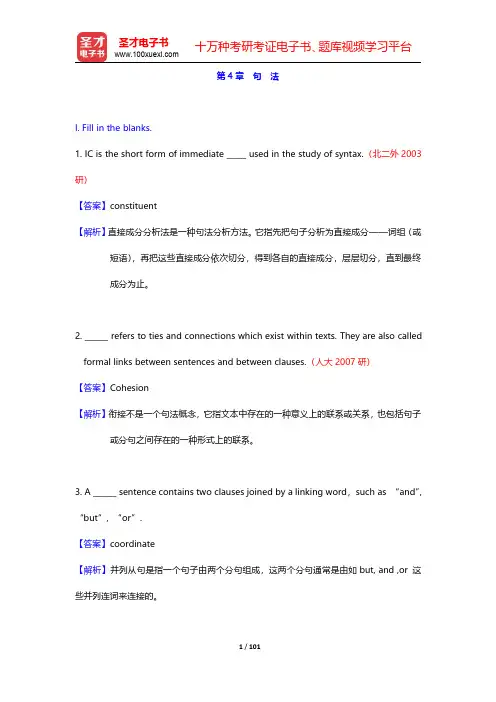
第4章句法I.Fill in the blanks.1.IC is the short form of immediate_____used in the study of syntax.(北二外2003研)【答案】constituent【解析】直接成分分析法是一种句法分析方法。
它指先把句子分析为直接成分——词组(或短语),再把这些直接成分依次切分,得到各自的直接成分,层层切分,直到最终成分为止。
2.______refers to ties and connections which exist within texts.They are also called formal links between sentences and between clauses.(人大2007研)【答案】Cohesion【解析】衔接不是一个句法概念,它指文本中存在的一种意义上的联系或关系,也包括句子或分句之间存在的一种形式上的联系。
3.A______sentence contains two clauses joined by a linking word,such as“and”,“but”,“or”.【答案】coordinate【解析】并列从句是指一个句子由两个分句组成,这两个分句通常是由如but,and,or这些并列连词来连接的。
4.A clause that takes a subject and a finite verb,and at the same time stands structurally alone is known as a______clause.【答案】finite【解析】限定性从句通常有一个主语和一个限定性动词,且在结构上是独立的。
5.Syntactic movement is dictated by rules traditionally called_____rules,whose operation may change the syntactic representation of a sentence.【答案】transformational【解析】句法移位是一种转换规则,指一个句子的任意成分从原来的位置移到另一个新位置。
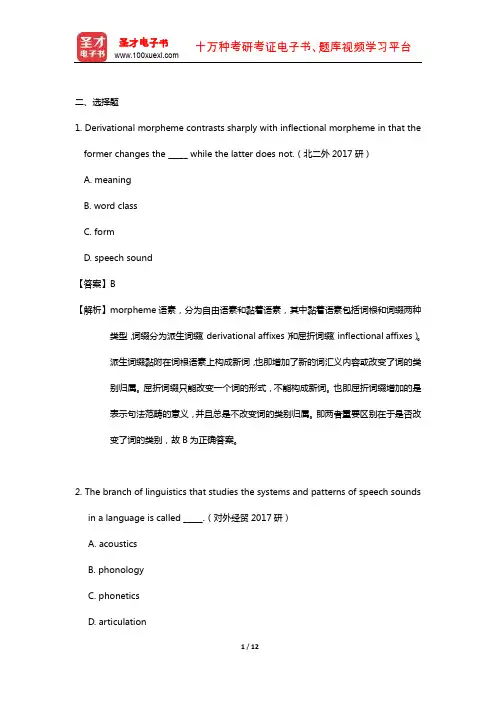
二、选择题1. Derivational morpheme contrasts sharply with inflectional morpheme in that the former changes the _____ while the latter does not.(北二外2017研)A. meaningB. word classC. formD. speech sound【答案】B【解析】morpheme语素,分为自由语素和黏着语素,其中黏着语素包括词根和词缀两种类型,词缀分为派生词缀(derivational affixes)和屈折词缀(inflectional affixes)。
派生词缀黏附在词根语素上构成新词,也即增加了新的词汇义内容或改变了词的类别归属。
屈折词缀只能改变一个词的形式,不能构成新词。
也即屈折词缀增加的是表示句法范畴的意义,并且总是不改变词的类别归属。
即两者重要区别在于是否改变了词的类别,故B为正确答案。
2. The branch of linguistics that studies the systems and patterns of speech soundsin a language is called _____.(对外经贸2017研)A. acousticsB. phonologyC. phoneticsD. articulation【答案】B【解析】音位学是研究人类语言中的语音模块系统和模式的方法。
3. Point out which item does not fall under the same category as the rest, and explain the reason in ONE sentence.(南京大学2007研)A. resolutionB. residentC. restartD. resignation【答案】C【解析】/s/ 在restart中位于清辅音前,所以被轻音化。
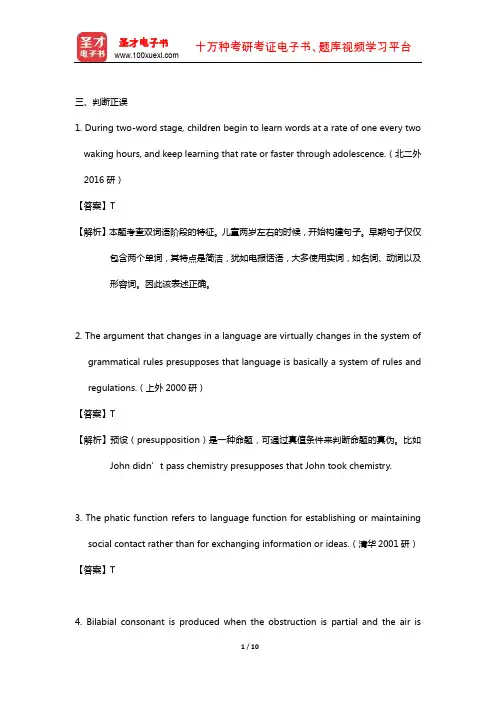
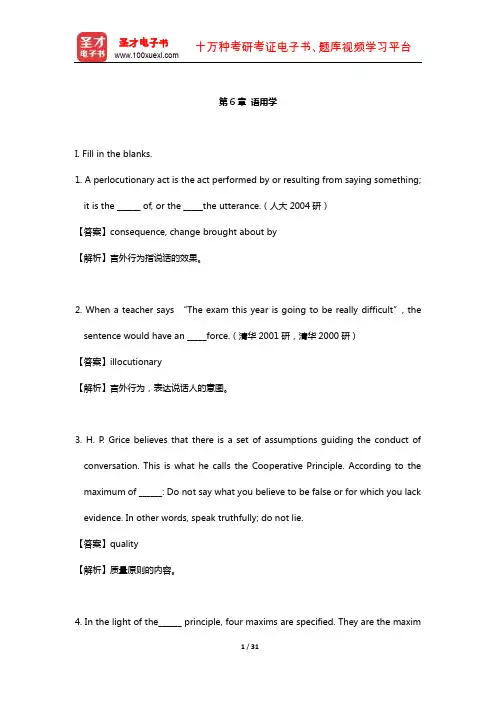
第6章语用学I. Fill in the blanks.1. A perlocutionary act is the act performed by or resulting from saying something; it is the ______ of, or the _____the utterance.(人大2004研)【答案】consequence, change brought about by【解析】言外行为指说话的效果。
2. When a teacher says “The exam this year is going to be really difficult”, the sentence would have an _____force.(清华2001研,清华2000研)【答案】illocutionary【解析】言外行为,表达说话人的意图。
3. H. P. Grice believes that there is a set of assumptions guiding the conduct of conversation. This is what he calls the Cooperative Principle. According to the maximum of ______: Do not say what you believe to be false or for which you lack evidence. In other words, speak truthfully; do not lie.【答案】quality【解析】质量原则的内容。
4. In the light of the______ principle, four maxims are specified. They are the maximof quantity, maxim of______, maxim of______ and the maxim of______.(中国人民大学2005年、吉林大学2004年研)【答案】cooperative; quality; relation; manner【解析】考查合作原则及四条次则:数量准则、质量准则、关联准则、方式准则。
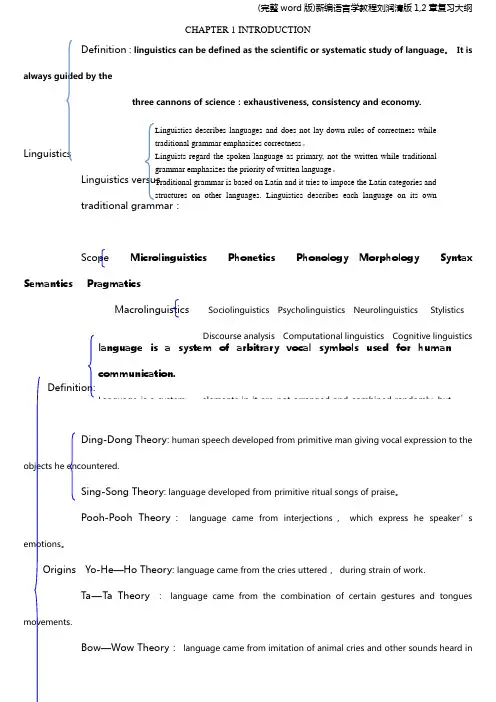
CHAPTER 1 INTRODUCTIONDefinition : linguistics can be defined as the scientific or systematic study of language 。
It isalways guided by thethree cannons of science :exhaustiveness, consistency and economy.LinguisticsLinguistics versus traditional grammar :Scope Microlinguistics Phonetics Phonology Morphology Syntax Semantics PragmaticsMacrolinguistics Sociolinguistics Psycholinguistics Neurolinguistics StylisticsDiscourse analysis Computational linguistics Cognitive linguisticsDefinition:Ding-Dong Theory: human speech developed from primitive man giving vocal expression to theobjects he encountered.Sing-Song Theory: language developed from primitive ritual songs of praise 。
Pooh-Pooh Theory : language came from interjections , which express he speaker ’semotions 。
Origins Yo-He —Ho Theory: language came from the cries uttered , during strain of work.Ta —Ta Theory : language came from the combination of certain gestures and tonguesmovements.Bow —Wow Theory : language came from imitation of animal cries and other sounds heard inLinguistics describes languages and does not lay down rules of correctness while traditional grammar emphasizes correctness 。
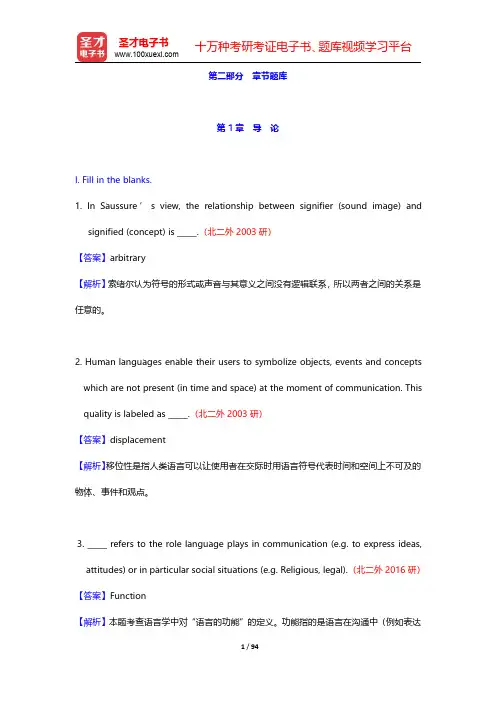
第二部分章节题库第1章导论I.Fill in the blanks.1.In Saussure’s view,the relationship between signifier(sound image)andsignified(concept)is_____.(北二外2003研)【答案】arbitrary【解析】索绪尔认为符号的形式或声音与其意义之间没有逻辑联系,所以两者之间的关系是任意的。
2.Human languages enable their users to symbolize objects,events and concepts which are not present(in time and space)at the moment of communication.This quality is labeled as_____.(北二外2003研)【答案】displacement【解析】移位性是指人类语言可以让使用者在交际时用语言符号代表时间和空间上不可及的物体、事件和观点。
3._____refers to the role language plays in communication(e.g.to express ideas, attitudes)or in particular social situations(e.g.Religious,legal).(北二外2016研)【答案】Function【解析】本题考查语言学中对“语言的功能”的定义。
功能指的是语言在沟通中(例如表达观点、态度)或在特定社交场合(如宗教、法律)中所起的作用。
4.The features that define our human languages can be called_____features.(北二外2006研)【答案】design【解析】人类语言区别于其他动物交流系统的特点是语言的区别特征,是人类语言特有的特征。
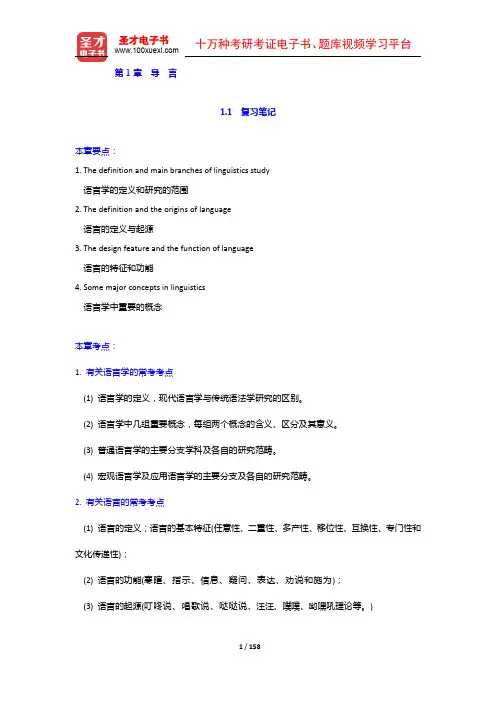
第1章导言1.1复习笔记本章要点:1.The definition and main branches of linguistics study语言学的定义和研究的范围2.The definition and the origins of language语言的定义与起源3.The design feature and the function of language语言的特征和功能4.Some major concepts in linguistics语言学中重要的概念本章考点:1.有关语言学的常考考点(1)语言学的定义,现代语言学与传统语法学研究的区别。
(2)语言学中几组重要概念,每组两个概念的含义、区分及其意义。
(3)普通语言学的主要分支学科及各自的研究范畴。
(4)宏观语言学及应用语言学的主要分支及各自的研究范畴。
2.有关语言的常考考点(1)语言的定义;语言的基本特征(任意性、二重性、多产性、移位性、互换性、专门性和文化传递性);(2)语言的功能(寒暄、指示、信息、疑问、表达、劝说和施为);(3)语言的起源(叮咚说、唱歌说、哒哒说、汪汪、噗噗、哟嘿吼理论等。
)本章内容索引:I.Definition of linguisticsII.Linguistics vs.traditional grammarIII.Scope of linguistics1.Microlinguistics2.MacrolinguisticsIV.Definition of languageV.Origins of language1.Ding-Dong Theory2.Sing-Song Theory3.Pooh-Pooh Theory4.Yo-He-Ho Theory5.Ta-Ta Theory6.Bow-Wow TheoryVI.Design features of language1.Arbitrariness2.Duality3.Productivity4.Interchangeability5.Displacement6.Specialization7.Cultural transmissionVII.Functions of language1.Phatic function/communion2.Directive functionrmative function4.Interrogative function5.Expressive function6.Evocative function7.Performative functionVIII.Some major concepts in linguistics1.Descriptive and prescriptive grammar2.Synchronic and diachronic linguisticsngue and parolepetence and performance5.Syntagmatic and paradigmatic relations6.Functionalism and formalismI.Definition of linguistics(语言学的定义)【考点:名词解释】The scientific or systemic study of language,which is always guided by the-three canons ofscience:exhaustiveness,consistency and economy.语言学是对语言的科学或系统的研究。
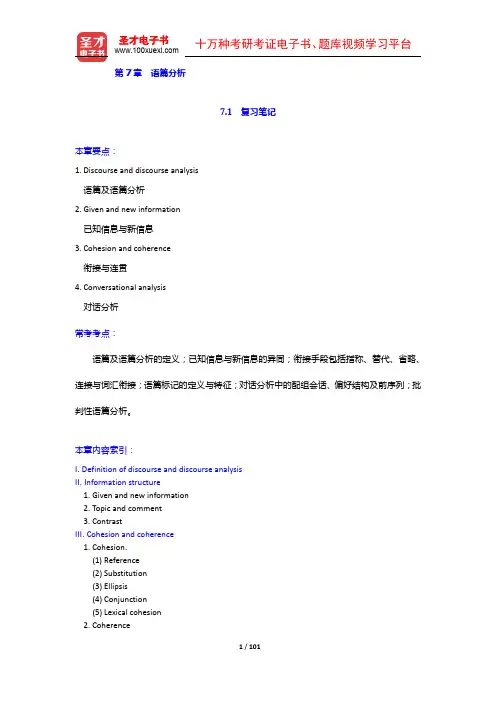
第7章语篇分析7.1复习笔记本章要点:1.Discourse and discourse analysis语篇及语篇分析2.Given and new information已知信息与新信息3.Cohesion and coherence衔接与连贯4.Conversational analysis对话分析常考考点:语篇及语篇分析的定义;已知信息与新信息的异同;衔接手段包括指称、替代、省略、连接与词汇衔接;语篇标记的定义与特征;对话分析中的配组会话、偏好结构及前序列;批判性语篇分析。
本章内容索引:I.Definition of discourse and discourse analysisrmation structure1.Given and new information2.Topic and comment3.ContrastIII.Cohesion and coherence1.Cohesion.(1)Reference(2)Substitution(3)Ellipsis(4)Conjunction(5)Lexical cohesion2.CoherenceIV.Discourse markers1.Definition2.Functional-pragmatic nature3.Features of discourse markersV.Conversational analysis1.Adjacency pairs2.Preference structure3.PresequencesVI.Critical discourse analysisI.Definition of discourse and discourse analysis(语篇及语篇分析的定义)1.Discourse(语篇)A general term for examples of language use,nguage which has been produced as the result of an act of communication.It refers to the larger units of language such as paragraphs, conversations,and interviews.泛指语言的运用,也就是说,语篇是人们进行交流的产物。
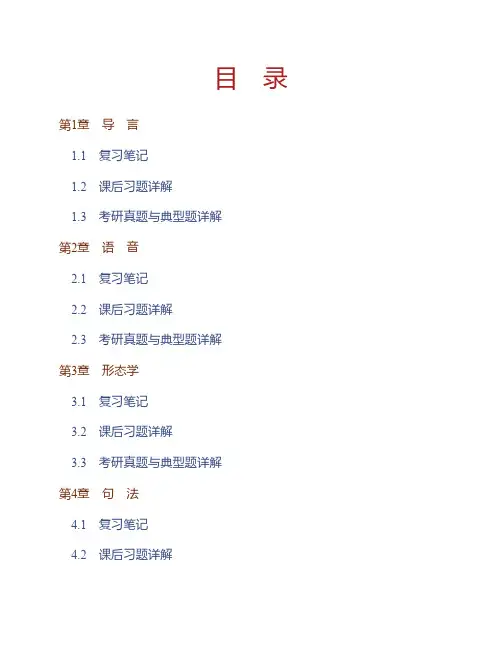
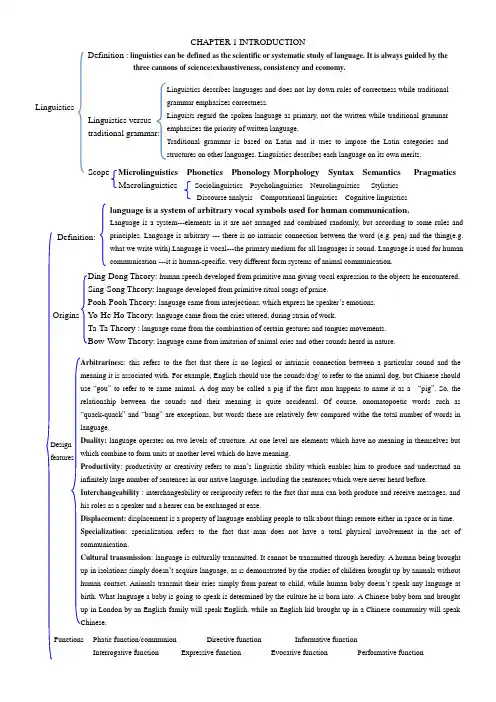
CHAPTER 1 INTRODUCTIONDefinition : linguistics can be defined as the scientific or systematic study of language. It is always guided by the three cannons of science:exhaustiveness, consistency and economy.LinguisticsLinguistics versus traditional grammar:Scope Microlinguistics Phonetics Phonology Morphology Syntax Semantics Pragmatics Macrolinguistics Sociolinguistics Psycholinguistics Neurolinguistics StylisticsDiscourse analysis Computational linguistics Cognitive linguisticsDefinition:Ding-Dong Theory: human speech developed from primitive man giving vocal expression to the objects he encountered. Sing-Song Theory: language developed from primitive ritual songs of praise.Pooh-Pooh Theory: language came from interjections, which express he speaker ’s emotions.Origins Yo-He-Ho Theory: language came from the cries uttered, during strain of work.Ta-Ta Theory : language came from the combination of certain gestures and tongues movements.Bow-Wow Theory: language came from imitation of animal cries and other sounds heard in nature.DesignfeaturesFunctionsLinguistics describes languages and does not lay down rules of correctness while traditional grammar emphasizes correctness. Linguists regard the spoken language as primary, not the written while traditional grammaremphasizes the priority of written language.Traditional grammar is based on Latin and it tries to impose the Latin categories and structures on other languages. Linguistics describes each language on its own merits. language is a system of arbitrary vocal symbols used for human communication. Language is a system---elements in it are not arranged and combined randomly, but according to some rules and principles. Language is arbitrary --- there is no intrinsic connection between the word (e.g. pen) and the thing(e.g.what we write with).Language is vocal---the primary medium for all languages is sound. Language is used for human communication ---it is human-specific, very different form systems of animal communication. Arbitrarines s: this refers to the fact that there is no logical or intrinsic connection between a particular sound and the meaning it is associated with. For example, English should use the sounds/d ɔg/ to refer to the animal dog, but Chinese should use “gou ” to refer to te same animal. A dog may be called a pig if the first man happens to name it as a “pig ”. So, the relationship between the sounds and their meaning is quite accidental. Of course, onomatopoetic words such as “quack-quack ” and “bang ” are exceptions, but words these are relatively few compared withe the total number of words in language. Duality: language operates on two levels of structure. At one level are elements which have no meaning in themselves but which combine to form units at another level which do have meaning. Productivity : productivity or creativity refers to man ’s linguistic ability which enables him to produce and understand an infinitely large number of sentences in our native language, including the sentences which were never heard before. Interchangeability : interchangeability or reciprocity refers to the fact that man can both produce and receive messages, and his roles as a speaker and a hearer can be exchanged at ease. Displacement: displacement is a property of language enabling people to talk about things remote either in space or in time. Specialization : specialization refers to the fact that man does not have a total physical involvement in the act of communication. Cultural transmission : language is culturally transmitted. It cannot be transmitted through heredity. A human being brought up in isolations simply doesn ’t acquire language, as is demonstrated by the studies of children brought up by animals without human contact. Animals transmit their cries simply from parent to child, while human baby doesn ’t speak any language at birth. What language a baby is going to speak is determined by the culture he is born into. A Chinese baby born and brought up in London by an English family will speak English, while an English kid brought up in a Chinese community will speak Chinese.Phatic function/communion Directive function Informative functionInterrogative function Expressive function Evocative function Performative functionSome major concepts in linguisticsDescriptive and prescriptive grammarDescriptive grammars attempt to tell what is in the language; while prescriptive grammars tell people what should be in the language.As traditional grammars tried to lay down rules, they are often called prescriptive. Most modern linguistics is descriptive.Synchronic and diachronic linguisticsWhen we study language at one particular time, it is called synchronic linguistics. When we study language developments through time, it is called diachronic or historical linguistics. Synchronic linguistics focuses on the state of language at any point in history while diachronic linguistics focuses on he difference in two or more than two tates of language over decades or centuries.Langue and paroleF.de Saussure made an important distinction between langue and parole. Langue refers to the abstract linguistic system shared by all the members of a speech community. Parole refers to particular realizations of langue. Langue is the social, conventional side of language, while parole is individualized speech.Competence and performanceAccording to Chomsky, competence refers to the knowledge that native speakers have of their language as a system of abstract formal relations, while performance refers to their actual linguistic behavior, that is , the actual use of this knowledge.Syntagmatic and paradigmatic relationsSaussure has put forward another pair of concepts: syntagmatic and paradigmatic relations. The former refers to the horizontal relationship between linguistic elements, which form linear sequences. The later means the vertical relationship between forms, which might occupy the same particular place in a structure.Functionalism and formalismFunctionalism or functional linguistics refers to the study of the forms of language in reference to their social function in communication. Formalism or formal linguistics is the study of the abstract forms of language and their internal relations.课后练习If language is partially defined as communication, can we call the noises that dogs make language? Why or why not? No,we can’t call the noises that dogs make as language even though language is partially defined as communication. There are two reasons for that: first, language is human-specific,it is a system of arbitrary vocal symbols used only for human communication. Second, language has design features which are totally lack in animal communication systems. For example, language has two levels of structures: at one level are elements which have no meaning in themselves but which combine to form units at another level which do have meaning. Noises made by dogs represent certain meaning but can not be further analyzed into smaller units.What is the difference between a prescriptive and a descriptive approach to language?Descriptive approach to language attempt to tell what is in the language, while prescriptive approach to language tells people what should be in the language. Most contemporary linguists believe that whatever occurs naturally in the language should be described. Certain forms are sued more regularly than others and by different people. Though some forms occur less frequently they should not be ignored. They can all be recorded and explained as aspects of the languages since hey are actually used.A wolf is able to express subtle gradations of emotion by different positions of the ears, the lips, and the tail. There are eleven postures of the tail that express such emotions as self-confidence, confident threat, lack of tension, uncertain threat, depression, defensiveness, active submission, and complete submission. This system seems to be complex. Suppose there were a thousand different emotions that the wolf could express in this way. Would you then say a wolf had a language similar to man’s ? If not, why not?No, we can not say a wolf has a language similar to that of men even though there were a thousand different emotions that the wolf could express with his positions of body parts. There are two reasons for that:First, language is a system of arbitrary vocal symbols used for human communication. Language is human-specific. Second, language has design features which are lack in animals’communication systems. For example, language has two levels of structures: at one level are elements which have no meaning in themselves but which combine to form units at another level which do have meaning. But in wolf’s communication system, one position stands for one certain meaning, and can not be further analyzed into smaller units. And no the other hand, human linguistic units can be grouped and regrouped, arranged and rearranged according to certain rules but those positions owned by wolf have no such features. Therefore, wolf’s this system is not so productive as human languages.Chapter 2 THE SOUNDS OF LANGUAGE INTRODUCTIONPhonology : is the description of the systems and patterns of speech sounds in a language.Phoneme:Minimal pairsandminimal sets\Free variationDistinctive featuressyllablesConsonant clusterSuprasegmentalsWith some phonetic knowledge we can give a much more precise description to speech sounds. And with somephonological knowledge we can become more aware of the functions of sounds in different languages. Moreimportantly, phonetics and phonology have made the greatest contribution to “teaching”machines to “talk”.Phoneme is the phonological units of language, and it is an abstract collection of phonetic features which anddistinguish meaning.For example, sip and zip is signaled by the fact that the initial sound of the first word is s/s/ and the initial sound of thesecond word is z/z/./s/and /z/can therefore distinguish or contrast words. Such distinctive sounds are called phonemes.Minimal pairs are pairs of words which differ from each other only by one sound.For example, chunk andjunk ,ban and bin, be and bat, fan and van, fine and vine, sink and zinc, site and side are minimal pairs in English.When a group of words can be differentiated each one from the others, by changing one phoneme (always in thesame position), then we have a minimal set. For example, a minimal set based on the vowel phonemes of Englishwould include feat, fit ,fate fat fought and foot, and one based on consonants could have big, pig, rig, fig, dig and wig.when two or more sounds occur in the same positon without any apparent change of meaning, they are said to be infree variation.For example, there are two pronunciation of the word either,we can say /i:δər/ and /’aıδər/.When a feature distinguishes one phoneme from another it is a distinctive feature (or a phonemic feature).For example, seal and zeal distinguishes by /s/ ad /z/,/s/ is voiceless and /z/ is voiced,so /s/ and /z/ is a voicingdifference.The English word beautiful consists of three speech units: beau-ti-ful. These units, which are often longer thanone sound and smaller than a whole word, are called syllables.Syllable structure syllableonset Rime(rhyme)Nucleus(peak) codaConsonant(s) vowel consonant(s)In English some words may contain a sequence of two or more consonants in one syllable, for example, /spl/ in/’splendid/. Sequences of consonants like this are called consonant clusters.Initial cluster: /spl/ in /’splӕʃ/ splash Final cluster: /st/ in /test/ test Medial cluster: /str/ in /’peıstrı/ pastryA word which begins with three-consonant clusters always observes three strict rules:The first consonant must be /s/The second phoneme must be /p /or /t/ or /k/The third consonant must be /l / or /r / or /w / or /j /Sound contrasts that extend over several segments (phonemes),and such contrasts are called suprasegmentals.Suprasegmental featuresStress IntonationWhen a word has more than one syllable, one ofthem will be pronounced with more prominencethan others. This brings us to another speechsound phenomenon, that of stress.When sounds which are identical as to their place ormanner features may differ in length, pitch or loudness.When speaking, people generally raise and lower thepitch of their voice. This phenomenon is calledintonation.Definition: The study of the speech sounds that occur in all human languages is called phonetics.Articulatory phonetics, which is the study of how speech sounds are produced, or “articulated ”. Three research fields Acoustic phonetics, which deals with the transmission of speech sounds through the air.Auditory phonetics, which deals with how speech sounds are perceived by the listener.ArticulatorsandfunctionsVoicedandvoiceless soundsNasalandoral soundsVariations of soundsV owelsClassification of English Speech Sounds Consonants Pharynx is a tube which begins just above the larynx. Velum or soft palate i s seen in the position that allows air to pass through the nose and the mouth. Hard palate is often called the “roof of the mouth ”, you can feel its smooth curved surface with your tongue. Alveolar ridge or alveolum is between the top front teeth and hard palate. Tongue can be moved into many different places and different shapes. Larynx is also an articulator. Notices Jaws are sometimes called articulators,but the jaws are not articulators in the same way as others. The nose and the nasal cavity not articulators as others. Teeth Lips When the vocal cords are spread apart, the airstream from the lungs is not obstructed at the space between vocal cords and passes freely. The sounds produced in this way are described as voiceless sounds. The sounds represented by /p/,/t/,/k/,and /s/ in the English words seep/si:p/,seat/si:t/,and seek/si:k/ are voiceless sounds. When the vocal cords are drawn together, the airstream forces its way through and causes them to vibrate. Sounds produced in this way are described as voiced sounds. The sounds represented by /b/, /d/, /g/ and /z/ in the English words cob/k ɒb/,cod/k ɒd/,cog/k ɒg/,and daze/de ız / are voiced sounds. When the velum is lowered, air escapes through the nose as well as the mouth; sounds produced this way are called nasal sounds. There are three nasal consonants /m/, /n/,and /ŋ/ in English. When the velum is raised all the way to touch the back of the throat, the passage through the nose is cut off. When the nasal passage is blocked in this way, the air can escape only through the mouth. Sounds produced this way are called oral sounds. /p/ and /b/ are oral sounds. Definition: vowels are sounds produced without obstruction, so o turbulence or a total stopping of the air can be perceived. Front vowels: /i:/ /ı/ /e/ /ɛ/ /ӕ/ /ɑ/ The height of the tongue Central vowels: /з:/ /ə/ /ʌ/ Back vowels: /u:/ /u/ /ɔ:/ /ɔ/ /ɑ:/ The shape of the lip Rounded vowels: /u:/ /u/ /ɔ:/ /ɔ/Unrounded vowels: /i:/ /ı/ /e/ /ɛ/ /ӕ/ /ɑ/ /з:/ /ə/ /ʌ/ /ɑ:/Open vowels: /ӕ/ /ɑ/ /ɔ/ /ɑ:/ The width of the mouth Close vowels: /i:/ /ı/ /u:/ /u/ Semi-open vowels: /ɔ://e/ /ɛ/ /з:/ /ə/ /ʌ/Consonants are sounds produced by constricting or obstructing the vocal tract at some places to divert, impede or completely shut off the flow of air in the oral cavity. Bilabials / p, b, m, w/ Labiodentals / f, v/Dentals /ө, δ /in terns of place of articulation Alveolars / t, d, n, s, z, r, l / Palatals / ʤ, ʧ / Velars /k, g, ŋ /glottal /h /Stops / p, b, t, d, k, g / Fricatives /f, v, ө, δ, s, z, ʃ, ʒ, h / Affricates / ʤ, ʧ /In terms of manners of articulation Liquids /l, r /Nasals /m, n, ŋ /Glides /j, w /Liaison: The phenomenon of the linking of two words in speech, in particular when the second word begins with a vowel, is called liaison. The phrase “an egg ” is often pronounced /ə’neg/.Elision : the loss of a sound or sounds in speech is called elision. The word “suppose ” is often pronounced as /sp əʊz/, “factory ” as /’f ӕktr ı/.Assimilation : the way that sounds belonging to one word or one syllable can cause changes in sounds belonging to neighboring words or syllables is called assimilation. In English the negative prefix occurs as “im-” before words such as “possible ”---”impossible ”.CAPTER 2 课后练习2.What is the test most often used for determining phonemes in a language?Minimal pair test or substitution test is the first rule of thumb to determine the phonemes of any language, that is , to see whether substituting one sound for another result in a different word. If it does , the two sound represent different phonemes. For example, we see from the contrast between fine and vine and between chunk and junk that /f /, /v /,/ʧ /and /ʤ/ must be phonemes in English because substituting /v/ for /f /,or /ʤ/ for /ʧ / produce a different word.3. What’s the difference between an open and a closed syllable?The units, which are often longer than one sound and smaller than a whole word, are called syllables. Syllables can be divided into two sorts: the open syllables and the closed syllables. Syllables like me, by or no that have an onset and a nucleus, but no coda are called open syllables; while the coda is present in the syllables like up, cup or hat, which is called closed syllables.4.For each group of sounds listed below, state the phonetic feature or features which they share/p/ /b/ /m/ feature: bilabial,stop,consonant/g/ /p/ /t/ /d/ /k/ /b/ feature: stop, consonant/ʊ/ /u:/ /ɒ/ feature: back, rounded, vowel the single feature that distinguishes the following pairs of sounds./ δ / : /ө,/ voi cing ( voiceless vs. voiced )/p /: /f / place of articulation ( bilabial vs. labio-dental ) /ı /: /e / the height of the tone rising. ( high vs. mid )/b /: /m / manner of articulation. (stop vs. nasal) /s /: /ʃ / place of articulation (alveolar vs. palatal) /s /: /δ / place of articulation (alveolar vs. dental)6.The following sets of minimal pairs show that English /p/ and /b/ contrast in initial, medial and final positions. Initial Medial finalpit/bit rapid/rabid cap/cabFind similar seets of minimal pairs for each pair of consonants given:Initial Medial final/k/-/g/ Kook/gook raking/raging lak/leg/m/-/n/ Moon/noon dime/dine beam/bean/b/-/v/ Berry/very dribble/drivel dub/dove/b/-/m/ Be/me ribbed/rimmed rib/rim/p/-/f/ Pat/fat depend/defend rap/raff7.The english data below provide examples of stress placement on certain verbs.A ap’pear col’lide e’rase ca’rouse cor’rode Ba’daptcol’lapsee’lectob’servetor’mentCas’tonishcon’sideri’maginede’termine‘promise1)Describe in words the stress placement on these verbs. Make sure you refer to syllable structure in your statement.2)Provide syllable representations of the words col’lide, e’lect, and con’sider in order to illustrate your conclusion about stress placement in these forms.1)Stress in languages may be predictable by rules: lexical category, morphological structure and number of syllables all seem to berelevant factors for the placement of stress in English words.For two-syllable verbs, the final(ultimate) syllable will receive main stress if tie has a long vowel or ends in at least two consonants. In this case, the first(penultimate) syllable may have secondary stress, contain an unstressed full vowel, or contain a reduced vowel. For example, a’dapt, e’lect.If the ultimate syllable does not have a long vowel or end in two or more consonants, the penultimate syllable is stressed, as in’promise. Otherwise, the main stress will be put on the second syllable. For example, ca’rouse, ob’serve, astonish, de’termine.If there is a double-letter in the word, the main stress should be put between them, or in other words, on the second one of the two. Such as ap’pear, cor’rode, col’lide, col’lase2)They are two-syllable words; therefore the final (ultimate ) syllable will receive main stress,, as col’lide, e’lect and con’side.。
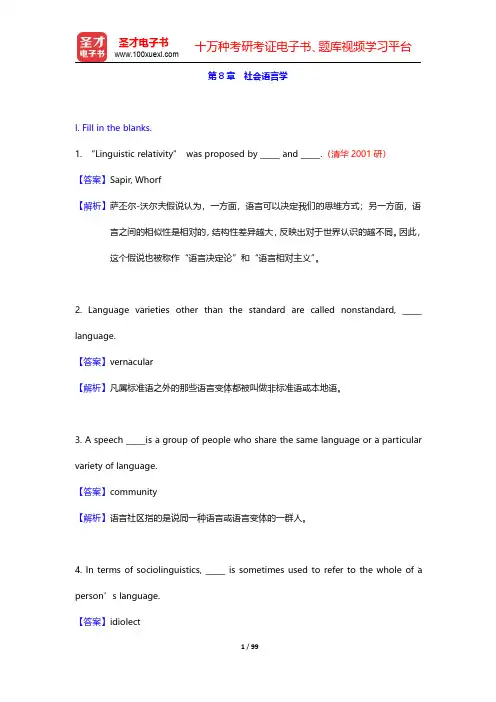
第8章社会语言学I.Fill in the blanks.1.“Linguistic relativity”was proposed by_____and_____.(清华2001研)【答案】Sapir,Whorf【解析】萨丕尔-沃尔夫假说认为,一方面,语言可以决定我们的思维方式;另一方面,语言之间的相似性是相对的,结构性差异越大,反映出对于世界认识的越不同。
因此,这个假说也被称作“语言决定论”和“语言相对主义”。
nguage varieties other than the standard are called nonstandard,_____ language.【答案】vernacular【解析】凡属标准语之外的那些语言变体都被叫做非标准语或本地语。
3.A speech_____is a group of people who share the same language or a particular variety of language.【答案】community【解析】语言社区指的是说同一种语言或语言变体的一群人。
4.In terms of sociolinguistics,_____is sometimes used to refer to the whole of a person’s language.【答案】idiolect【解析】从社会语言学的角度讲,个人习语指个人语言风格。
5.In many societies of the world,we find a large number of people who speak more than one language.As a characteristic of societies,_____inevitably results from the coming into contact of people with different cultures and different languages.【答案】bilingualism【解析】双语现象源于不同文化和不同语言相互交流的结果。
第2章语音I. Fill in the blanks.1. The sound B. can be described with “_____, bilabial, stop”.(北二外2004研)【答案】voiced【解析】/b/是双唇音,爆破音,浊音。
2. Consonant articulations are relatively easy to feel and as a result are most conveniently described in terms of _____ and manner of articulation.(北二外2004研)【答案】place【解析】辅音根据发音方式和发音部位进行分类。
3. ______ are produced by constricting or obstructing the vocal tract at some place to divert, impede, or completely shut off the flow of air in the oral cavity.(中山大学2006研)【答案】Consonants【解析】发音时,声道的某些部位受到压缩或阻碍后,使得气流在口腔里转向、受阻或完全被阻塞而产生的音叫做辅音。
4. Voicing refers to the _____ of the vocal folds.(北二外2016研)【答案】vibration【解析】本题考查辅音发音过程中的清浊特征的定义。
若发音过程中,声带振动,则为浊辅音,反之则为清辅音。
5. Consonant articulations are relatively easy to feel, and as a result are most conveniently described in terms of place and _____ of articulation.(北二外2008研)【答案】manner【解析】辅音根据发音方式和发音部位进行分类。
第4章句法I. Fill in the blanks.1. IC is the short form of immediate _____ used in the study of syntax.(北二外2003研)【答案】constituent【解析】直接成分分析法是一种句法分析方法。
它指先把句子分析为直接成分——词组(或短语),再把这些直接成分依次切分,得到各自的直接成分,层层切分,直到最终成分为止。
2. ______ refers to ties and connections which exist within texts. They are also called formal links between sentences and between clauses.(人大2007研)【答案】Cohesion【解析】衔接不是一个句法概念,它指文本中存在的一种意义上的联系或关系,也包括句子或分句之间存在的一种形式上的联系。
3. A ______ sentence contains two clauses joined by a linking word,such as “and”, “but”, “or”.【答案】coordinate【解析】并列从句是指一个句子由两个分句组成,这两个分句通常是由如but, and ,or 这些并列连词来连接的。
4. A clause that takes a subject and a finite verb, and at the same time stands structurally alone is known as a______ clause.【答案】finite【解析】限定性从句通常有一个主语和一个限定性动词,且在结构上是独立的。
5. Syntactic movement is dictated by rules traditionally called _____ rules, whose operation may change the syntactic representation of a sentence.【答案】transformational【解析】句法移位是一种转换规则,指一个句子的任意成分从原来的位置移到另一个新位置。
CHAPTER 1 INTRODUCTIONDefinition : linguistics can be defined as the scientific or systematic study of language. It is always guided by the three cannons of science:exhaustiveness, consistency and economy.LinguisticsLinguistics versustraditional grammar:Linguistics describes languages and does not lay down rules of correctness whiletraditional grammar emphasizes correctness.Linguists regard the spoken language as primary, not the written while traditional grammar emphasizes the priority of written language.Traditional grammar is based on Latin and it tries to impose the Latin categories and structures on other languages. Linguistics describes each language on its own merits.Scope Microlinguistics Phonetics Phonology Morphology Syntax Semantics Pragmatics Macrolinguistics Sociolinguistics Psycholinguistics Neurolinguistics StylisticsDiscourse analysis Computational linguistics Cognitive linguisticslanguage is a system of arbitrary vocal symbols used for human communication.Language is a system---elements in it are not arranged and combined randomly, but according to some rules and Definition:principles. Language is arbitrary--- there is no intrinsic connection between the word (e.g. pen) and the thing(e.g.what we write with).Language is vocal---the primary medium for all languages is sound. Language is used for humancommunication ---it is human-specific, very different form systems of animal communication.Ding-Dong Theory: human speech developed from primitive man giving vocal expression to the objects he encountered.Sing-Song Theory: language developed from primitive ritual songs of praise.Pooh-Pooh Theory: language came from interjections, which express he speaker’s emotions.Origins Yo-He-Ho Theory: language came from the cries uttered, during strain of work.Ta-Ta Theory : language came from the combination of certain gestures and tongues movements.Bow-Wow Theory: language came from imitation of animal cries and other sounds heard in nature.Arbitrarines s: this refers to the fact that there is no logical or intrinsic connection between a particular sound and the meaning it is associated with. For example, English should use the sounds/d ?g/ to refer to the animal dog, but Chinese should use “gou”to refer to te same animal. A dog may be called a pig if the first man happens to name it as a“pig”. So, the relationship between the sounds and their meaning is quite accidental. Of course, onomatopoetic words such as “quack-quack”and“bang”are exceptions, but words these are relatively few compared withe the total number of words inlanguage.Design Duality: language operates on two levels of structure. At one level are elements which have no meaning in themselves but features which combine to form units at another level which do have meaning.Productivity: productivity or creativity refers to man’s linguistic ability which enables him to produce and understand an infinitely large number of sentences in our native language, including the sentences which were never heard before.Interchangeability : interchangeability or reciprocity refers to the fact that man can both produce and receive messages, and his roles as a speaker and a hearer can be exchanged at ease.Displacement: displacement is a property of language enabling people to talk about things remote either in space or in time.Specialization: specialization refers to the fact that man does not have a total physical involvement in the act of communication.Cultural transmission : language is culturally transmitted. It cannot be transmitted through heredity. A human being brought up in isolations simply doesn ’tacquire language, as is demonstrated by the studies of children brought up by animals without human contact. Animals transmit their cries simply from parent to child, while human baby doesn’tspeak any language at birth. What language a baby is going to speak is determined by the culture he is born into. A Chinese baby born and broughtup in London by an English family will speak English, while an English kid brought up in a Chinese community will speakChinese.Functions Phatic function/communion Directive function Informative functionInterrogative function Expressive function Evocative function Performative functionSome major concepts in linguisticsDescriptive and prescriptive grammarDescriptive grammars attempt to tell what is in the language; while prescriptive grammars tell people what should be in the language.As traditional grammars tried to lay down rules, they are often called prescriptive. Most modern linguistics is descriptive.Synchronic and diachronic linguisticsWhen we study language at one particular time, it is called synchronic linguistics. When we study language developments through time, it is called diachronic or historical linguistics. Synchronic linguistics focuses on the state of language at any point in history while diachronic linguistics focuses on he difference in two or more than two tates of language over decades or centuries.Langue and paroleF.de Saussure made an important distinction between langue and parole. Langue refers to the abstract linguistic system shared by all the members of a speech community. Parole refers to particular realizations of langue. Langue is the social, conventional side of language, while parole is individualized speech.Competence and performanceAccording to Chomsky, competence refers to the knowledge that native speakers have of their language as a system of abstract formal relations, while performance refers to their actual linguistic behavior, that is , the actual use of this knowledge.Syntagmatic and paradigmatic relationsSaussure has put forward another pair of concepts: syntagmatic and paradigmatic relations. The former refers to the horizontal relationship between linguistic elements, which form linear sequences. The later means the vertical relationship between forms, which might occupy the same particular place in a structure.Functionalism and formalismFunctionalism or functional linguistics refers to the study of the forms of language in reference to their social function in communication. Formalism or formal linguistics is the study of the abstract forms of language and their internal relations.课后练习If language is partially defined as communication, can we call the noises that dogs make language? Why or why not?No,we can ’tcall the noises that dogs make as language even though language is partially defined as communication. There are two reasons for that: first, language is human-specific,it is a system of arbitrary vocal symbols used only for human communication. Second, language has design features which are totally lack in animal communication systems. For example, language has two levels of structures:at one level are elements which have no meaning in themselves but which combine to form units at another level which do have meaning. Noises made by dogs represent certain meaning but can not be further analyzed into smaller units.What is the difference between a prescriptive and a descriptive approach to language?Descriptive approach to language attempt to tell what is in the language, while prescriptive approach to language tells people what should be in the language. Most contemporary linguists believe that whatever occurs naturally in the language should be described. Certain forms are sued more regularly than others and by different people. Though some forms occur less frequently they should not be ignored. They can allbe recorded and explained as aspects of the languages since hey are actually used.A wolf is able to express subtle gradations of emotion by different positions of the ears, the lips, and the tail. There are eleven postures of the tail that express such emotions as self-confidence, confident threat, lack of tension, uncertain threat, depression, defensiveness, active submission, and complete submission. This system seems to be complex. Suppose there were a thousand different emotions that the wolf could express in this way. Would you then say a wolf had a language similar to man ’s ? If not, why not?No, we can not say a wolf has a language similar to that of men even though there were a thousand different emotions that the wolf could express with his positions of body parts. There are two reasons for that:First, language is a system of arbitrary vocal symbols used for human communication. Language is human-specific. Second, language has design features which are lack in animals’communication systems. For example, language has two levels of structures: at one level are elements which have no meaning in themselves but which combine to form units at another level which do have meaning. But in wolf’s communication system, one position stands for one certain meaning, and can not be further analyzed into smaller units. And no the other hand, human linguistic units can be grouped and regrouped, arranged and rearranged according to certain rules but those positions ownedby wolf have no such features. Therefore, wolf ’s this system is not so productive as human languages.Chapter 2 THE SOUNDS OF LANGUAGEWith some phonetic knowledge we can give a much more precise description to speech sounds. And with some INTRODUCTIONphonological knowledge we can become more aware of the functions of sounds in different languages. Moreimportantly, phonetics and phonology have made the greatest contribution to “teaching”machines to “talk ”.Phonology : is the description of the systems and patterns of speech sounds in a language.Phoneme is the phonological units of language, and it is an abstract collection of phonetic features which anddistinguish meaning.Phoneme:Minimal pairsandminimal sets \Free variation For example, sip and zip is signaled by the fact that the initial sound of the first word is s/s/ and the initial sound of the second word is z/z/./s/and /z/can therefore distinguish or contrast words. Such distinctive sounds are called phonemes. Minimal pairs are pairs of words which differ from each other only by one sound. For example, chunk andjunk ,ban and bin, be and bat, fan and van, fine and vine, sink and zinc, site and side are minimal pairs in English.When a group of words can be differentiated each one from the others, by changing one phoneme (always in the same position), then we have a minimal set. For example, a minimal set based on the vowel phonemes of English would include feat, fit ,fate fat fought and foot, and one based on consonants could have big, pig, rig, fig, dig and wig.when two or more sounds occur in the same positon without any apparent change of meaning, they are said to be in free variation.For example, there are two pronunciation of the word either,we can say /i: δ?r/ and /’a?δ?r/.When a feature distinguishes one phoneme from another it is a distinctive feature (or a phonemic feature). For example, seal and zeal distinguishes by /s/ ad /z/,/s/ is voiceless and /z/ is voiced,so /s/ and /z/ is a voicingdifference.The English word beautiful consists of three speech units: beau-ti-ful. These units, which are often longer thanone sound and smaller than a whole word, are called syllables.Syllable structure syllablesyllablesonset Rime(rhyme)Nucleus(peak)codaConsonant(s)vowel consonant(s)Consonant cluster In English some words may contain a sequence of two or more consonants in one syllable, for example, /spl/ in /’splendid/. Sequences of consonants like this are called consonant clusters.Initial cluster: /spl/ in / ’spl?? / splash Final cluster: /st/ in /test/ test Medial cluster: /str/ in / ’pe?str?/ pastryA word which begins with three-consonant clusters always observes three strict rules:The first consonant must be /s/The second phoneme must be /p /or /t/ or /k/The third consonant must be /l / or /r / or /w / or /j /Sound contrasts that extend over several segments (phonemes),and such contrasts are called suprasegmentals.Suprasegmental featuresStressSuprasegmentalsWhen a word has more than one syllable, one ofthem will be pronounced with more prominencethan others. This brings us to another speechsound phenomenon, that of stress.Distinctive featuresIntonationWhen sounds which are identical as to their place or manner features may differ in length, pitch or loudness. When speaking, people generally raise and lower the pitch of their voice. This phenomenon is called intonation.Definition: The study of the speech sounds that occur in all human languages is called phonetics.Articulatory phonetics, which is the study of how speech sounds are produced, or“articulated”. Three research fields Acoustic phonetics, which deals with the transmission of speech sounds through the air.Auditory phonetics, which deals with how speech sounds are perceived by the listener.Articulatorsand functionsVoiced and Pharynx is a tube which begins just above the larynx.Velum or soft palate i s seen in the position that allows air to pass through the nose and the mouth.Hard palate is often called the“roof of the mouth”, you can feel its smooth curved surface with your tongue. Alveolar ridge or alveolum is between the top front teeth and hard palate.Tongue can be moved into many different places and different shapes.TeethLarynx is also an articulator.LipsNotices Jaws are sometimes called articulators,but the jaws are not articulators in the same way as others.The nose and the nasal cavity not articulators as others.When the vocal cords are spread apart, the airstream from the lungs is not obstructed at the space between vocal cords and passes freely. The sounds produced in this way are described as voiceless sounds. The sounds represented by /p/,/t/,/k/,and /s/ in the English words seep/si:p/,seat/si:t/,and seek/si:k/ are voiceless sounds.voiceless soundsNasalandoral soundsVariationsofsoundsWhen the vocal cords are drawn together, the airstream forces its way through and causes them to vibrate.Sounds produced in this way are described as voiced sounds. The sounds represented by /b/, /d/, /g/ and /z/ in the English words cob/k ? b/,cod/k ? d/,cog/k ? g/,and daze/de ?z/ are voiced sounds.When the velum is lowered, air escapes through the nose as well as the mouth; sounds produced this wayare called nasal sounds. There are three nasal consonants /m/, /n/,and ?// in English.When the velum is raised all the way to touch the back of the throat, the passage through the nose is cut off.When the nasal passage is blocked in this way, the air can escape only through the mouth. Sounds produced this way are called oral sounds. /p/ and /b/ are oral sounds.Liaison: The phenomenon of the linking of two words in speech, in particular when the second word begins witha vowel, is called liaison. The phrase “an egg”is often pronounced /?’neg/.Elision :the loss of a sound or sounds in speech is called elision. The word“suppose”is often pronounced as/sp?? z/, “factory ”as / ’f? ktr?/.Assimilation : the way that sounds belonging to one word or one syllable can cause changes in sounds belonging to neighboring words or syllables is called assimilation. In English the negative prefix occurs as“im-”before words such as“possible”---”impossible”.Classification ofEnglish Speech SoundsDefinition: vowels are sounds produced without obstruction, so o turbulence or a total stopping Vowels of the air can be perceived.Front vowels: /i:/ / ?/ /e/ / ?/ /? / /ɑ/The height of the tongue Central vowels: / з:/ /?/ /?/Back vowels: /u:/ /u/ / ?:/ / ?/ / ɑ:/The shape of the lip Rounded vowels: /u:/ /u/ / ?:/ / ?/Unrounded vowels: /i:/ / ?/ /e/ / ?/ /? / /ɑ/ /з:/ /?/ /?/ / ɑ:/Open vowels: /? / /ɑ/ / ?/ / ɑ:/The width of the mouth Close vowels:/i:/ / ?/ /u:/ /u/Semi-open vowels: /?:/ /e/ / ?/ /з:/ /?/ /?/Consonants are sounds produced by constricting or obstructing the vocal tract at someplaces to divert, impede or completely shut off the flow of air in the oral cavity.Bilabials / p, b, m, w/Labiodentals / f, v/Consonants Dentals / ?, δ/in terns of place of articulation Alveolars / t, d, n, s, z, r, l /Palatals / ? , ? /Velars /k, g, ? /glottal /h /Stops / p, b, t, d, k, g /Fricatives /f, v, ?, δ, s, z, ?, ?, h /Affricates / ? , ? /In terms of manners of articulation Liquids /l, r /Nasals /m, n, ? /Glides /j, w /CAPTER 2课后练习2. What is the test most often used for determining phonemes in a language?Minimal pair test or substitution test is the first rule of thumb to determine the phonemes of any language, that is , to see whether substituting one sound for another result in a different word. If it does , the two sound represent different phonemes. For example, we see from the contrast between fine and vine and between chunk and junk that /f /, /v /,/ ? /and / ? / must be phonemes in English because substituting /v/ for /f /,or / ? / for / ? / produce a different word.3. What ’s the difference between an open and a closed syllable?The units, which are often longer than one sound and smaller than a whole word, are called syllables. Syllables can be divided into two sorts: the open syllables and the closed syllables. Syllables like me, by or no that have an onset and a nucleus, but no coda are called open syllables; while the coda is present in the syllables like up, cup or hat, which is called closed syllables.4. For each group of sounds listed below, state the phonetic feature or features which they share/p/ /b/ /m/feature: bilabial,stop,consonant/g/ /p/ /t/ /d/ /k/ /b/feature: stop, consonant/?/ /u:/ / ?/feature: back, rounded, vowel5. Name the single feature that distinguishes the following pairs of sounds./δ / : /?,/ voicing ( voiceless vs. voiced )/p /: /f /place of articulation ( bilabial vs. labio-dental ) /? /: /e /the height of the tone rising. ( high vs. mid )/b /: /m /manner of articulation. (stop vs. nasal) /s /: /? /place of articulation (alveolar vs.palatal)/s /: /δplace/ of articulation (alveolar vs. dental)6. The following sets of minimal pairs show that English /p/ and /b/ contrast in initial, medial and final positions.Initial Medial finalpit/bit rapid/rabid cap/cabFind similar seets of minimal pairs for each pair of consonants given:Initial Medial final/k/-/g/Kook/gook raking/raging lak/leg/m/-/n/Moon/noon dime/dine beam/bean/b/-/v/Berry/very dribble/drivel dub/dove/b/-/m/Be/me ribbed/rimmed rib/rim/p/-/f/Pat/fat depend/defend rap/raff7. The english data below provide examples of stress placement on certain verbs.A B Cap’pear a’dapt as’tonishcol’lide col ’lapse con’sidere’rase e’lect i’magineca’rouse ob’serve de’terminecor ’rode tor ’ment‘promise1)Describe in words the stress placement on these verbs. Make sure you refer to syllable structure in your statement.2)Provide syllable representations of the words col ’lide, e’lect, and con’sider in order to illustrate your conclusion about stress placement in these forms.1)Stress in languages may be predictable by rules: lexical category, morphological structure and number of syllables all seem to berelevant factors for the placement of stress in English words.For two-syllable verbs, the final(ultimate) syllable will receive main stress if tie has a long vowel or ends in at least two consonants. In this case, the first(penultimate) syllable may have secondary stress, contain an unstressed full vowel, or contain a reduced vowel. For example, a’dapt, e’lect.If the ultimate syllable does not have a long vowel or end in two or more consonants, the penultimate syllable is stressed, as in ’promise. Otherwise, the main stress will be put on the second syllable. For example, ca ’rouse, ob’serve, astonish, de’termine.If there is a double-letter in the word, the main stress should be put between them, or in other words, on the second one of the two. Such as ap’pear, cor’rode, col ’lide, col ’lase2)They are two-syllable words; therefore the final (ultimate ) syllable will receive main stress,, as col’lide, e’lect and con’side.。
1.1.1 填空判断:①linguistics can be defined as the scientific or systematic study of language。
It is a science studies the rules systems and principles of language。
3 cannons(标准):exhaustiveness全面性consistency一致性 economy.②linguistics study the origin, growth, organization。
Nature and development of language and discovers the general rules and principles governing language。
2 purposes: study the nature, establish a theory and describe language by that theory; examines all language and seeks understanding ways to fulfill the needs human need。
1.1.2 填空判断选择:Linguistics differ from traditional grammar:①linguistics describes languages and does not lay down rules of correctness. ②linguists regard spoken as primary not written. Speech came earlier than writing system。
③traditional grammar based on Latin while linguistics describes each language on its own merits。
第7章语篇分析I. Fill in the blanks.1. ______ refers to ties and connections which exist within texts. They are also called formal links between sentences and between clauses.(人大2007研)【答案】Cohesion【解析】衔接不是一个句法概念,它指文本中存在的一种意义上的联系或关系,也包括句子或分句之间存在的一种形式上的联系。
2. ______ is the information that the addresser believes is known to the addressee, while ______ is the information that the addresser believes is not known to the addressee.【答案】Given information; new information【解析】已知信息是指说话者认为听话者已经知道的信息,而新信息是指说话者认为听话者不知道的信息。
3. ______ represents what the utterance is about; ______ is what is said about it. 【答案】The topic; the comment【解析】话题是谈话的主题,述题是围绕主题所谈论的内容。
Ⅱ. True or False.1. All languages have some differences in verb forms which are used to produce cohesion.(南开大学2005研)【答案】T【解析】语言中的动词会有不同的形式来连接上下文。
2. One of properties of the adjacency pairs is that the form and content of the first part depends on the type of the second part.【答案】F【解析】配租对话的其中一个特征是第二部分的内容与构成取决于第一部分。
四、术语解释1. connotation(中山大学2018研)【答案】In the philosophers’usage, connotation, opposite to denotation, means the properties of the entity a word denotes. For example, the connotation of human is “biped”, “featherless”,“rational”, etc. Some connotations may be shared by a group of people of the same cultural or social background, sex, or age; others may be restricted to one or several individuals and depend on their personal experience.2. morpheme(武汉大学2013研)【答案】Morpheme: Morpheme is the smallest unit of language in terms of relationship between expression and content, a unit that cannot be divided into further smaller units without destroying or drastically altering the meaning, whether it is lexical or grammatical. For example, in boys, there are two morphemes: “boy”and “-s”; in international, there are three morphemes: “inter-”“nation”and “-al”.3. implicature(南开大学2012研)【答案】According to Grice, it refers to the extra meaning not contained in the utterance, but understandable to the listener only when he shares the speaker’s knowledge or he knows why and how he violates intentionally one of the fourmaxims of CP.4. arbitrariness(四川大学2006研)【答案】Arbitrariness is one of the design features of language. It refers to the fact that there is no logical or intrinsic connection between a particular sound and the meaning it is associated with. There is no reason, for example, why English should use the sounds /dɒg/ to refer to the animal dog, or why Chinese should use “gou”to refer to the same animal. The relationship between the sounds and their meaning is quite accidental.5. cohesion(中山大学2018研)【答案】Cohesion refers to relations of meaning that exist within the text, and that define it as a text. The cohesive devices usually include: conjunction, ellipsis, lexical collocation, lexical repetition, reference, substitution, and so on.6. cooperative principle(北师大2003研)【答案】Cooperative principle was proposed and formulated by Grice. It expresses that in making a conversation, the participants must first of all be willing to cooperate; otherwise, it would not be possible for them to carry on the talk. It goes like this: “make your conversational contribution such as is required, at the stage at which it occurs, by the accepted purpose or direction of the talk exchange in which you are engaged”. This principle can be further specified as the four followingmaxims: Quantity, Quality, Relation; Manner.7. conceptual meaning (of a word)(上海交大2006研)【答案】Conceptual meaning. According to Leech, conceptual meaning refers to the logical, cognitive, or denotative content of the meaning of a word. It is concerned with the relationship between a word and the thing it refers to. For example, the conceptual meaning of “human”is any person such as John and Mary.8. initialism(人大2008研)【答案】Some new words are composed of the first letters of a series of words, esp. the name of an organization when it has a heavily modified head words. Words of this kind are called initialisms. Initialism is different from acronym in that the former cannot be pronounced as a new word, but has to be pronounced by saying each letter in them. For example, VIP, WTO, BBC etc.9. deep structure(上外2000研)【答案】Deep structure is a central theoretical term in generative grammar opposed to surface structure. It is the abstract syntactic representation of a sentence—an underlying level of structural organization which specific all the factors governing the way the sentence should be interpreted.10. constituent analysis(北外2015研)【答案】a. Definition: Constituent analysis (also called Immediate constituent analysis or IC Analysis) refers to the analysis of a sentence in terms of its immediate constituents—word groups (or phrases), which are in turn analyzed into the immediate constituents of their own, and the process goes on until the ultimate constituents are reached.b. Advantages: Through IC analysis, the internal structure of a sentence may be demonstrated clearly, and ambiguities, if any, will be revealed.c. Problems:①It is not always possible to cut any construction, at any level into two parts.②Discontinuous constituents will be hard to deal with in IC analysis and there are structural ambiguities which cannot be revealed by IC analysis.11. langue(华南理工2017研)【答案】Langue is proposed by Saussure to distinguish from parole. Langue refers to the abstract linguistic system shared by all the members of a speech community. Parole refers to particular realizations of langue. Langue is the social, conventional side of language, while parole is individualized speech. Langue is the code, and parole is the message. Parole is the concrete manifestation of language either through speech or writing. Langue is the abstract knowledge necessary for speaking, listening, writing and reading. It is relatively stable and systematic, whereas parole is more variable and may change according to contextual factors.Langue and parole together constitute language.12. linguistic determinism(中山大学2018研)【答案】Linguistic Determinism is a theory which believes that our language will influence or decide our way of looking at the world. In a loose sense, linguistic determinism, linguistic relativity, and the Sapir-Whorf hypothesis can be regarded as synonyms.13. manner of articulation(武汉大学2010研)【答案】manner of articulation: It refers to the actual relationship between the articulators and thus the way in which the air passes through certain parts of the vocal tract. The manner of articulation refers to ways in which articulation can be accomplished: (a) the articulators may close off the oral tract for an instance or a relatively long period; (b) they may narrow the space considerably or (c) they may simply modify the shape of the tract by approaching each other. For example, in English, [p, b, t, d, k, g] are stops.14. Pidgins and Creoles(上海交大2007研)【答案】It is a language which develops as a contact language when groups of people who speak different languages try to communicate with one another on a regular basis. The language Tok Pisin is an example of pidgin. Creole is a pidgin language which has become the native language of a group of speakers, beingused for all or many of their daily communicative needs. For example, a French-based creole is spoken by the majority of the population in Haiti.15. error analysis(人大2008研)【答案】Error Analysis (EA) refers to the study and analysis of the errors made by second and foreign language learners in order to identify causes of errors of common difficulties in language learning. It is an alternative to contrastive analysis since not all learners’mistakes or errors occur because of the inter-language influence that contrastive analysis can explain. By using error, analysis, linguists can analyze intra-language error such as over-generalization.16. polysemy(中山大学2018研)【答案】Polysemy means a single word having several or many meanings. According to Crystal: Polysemy is a term used in semantic analysis to refer to a lexical item which has a range of different meanings. Polysemic words are signs of an advanced culture. Polysemy is also an essential feature of a language’s economy and efficiency.17. blending(北外2015研)【答案】Blending is a kind of word formation. It means a process in which two words are blended by joining together the initial part of the first word and the final part of the second word, or by joining the initial parts of the two words, such as faction。
刘润清《新编语言学教程》-考研真题详解
1. When air is forced out of the lungs, it causes the _____ _____ to vibrate.(中山大学2018研)
【答案】vocal folds查看答案
【解析】语音产生是以气流为能量来源的。
在大多数情况下,气流源自肺部,气流从肺中压出,引起声带的振动。
2. _____ is the ability of language to refer to contexts removed from the speaker’s immediate situation.(北二外2016研)
【答案】Displacement查看答案
【解析】本题考查语言本质特征的移位性。
移位性指的是就内容或者思想的表达来讲,人类语言的使用是不受时空限制的,可以用于涉及真实的或者想象的,过去的、现在的或将来的事情。
这不同于动物“语言”,因为大多数动物的“语言”需要“即时刺激控制”。
3. One of the important distinctions in linguistics is _______ and performance.(人大2006研)
【答案】competence查看答案
【解析】语言能力指理想的语言使用者关于语言规则的语言知识,语言应用指语言交际中关于语言规则知识的实际使用。
4. Phonetics is the study of ______ sounds that the human voice is capable of creating whereas phonology is the study of a subset of those sounds that constitute language and meaning.(北京邮电大学2015研)
【答案】speech查看答案
【解析】本题考查语音学和音系学的含义。
语音学研究语音的发生、传递和感知。
音系学研究的是语言的语音系统。
换句话说,音系学研究的是说话人为表达意义而系统地选择语音的方法。
5. A principal distinction between morphology and syntax is that the former is concerned with the internal composition of a word, whereas the latter is concerned with _____ of words.(中山大学2017研)
【答案】combinations查看答案
【解析】Morphology is concerned with the internal organization of words. It studies the minimal units of meaning-morphemes and word-formation processes. Syntax is the study of the rules governing the ways different constituents are combined to form sentences in a language, or the study of the interrelationships between elements in sentence structure.
6. Human language is arbitrary. This refers to the fact that there is no logical or intrinsic connection between a particular sound and the ______ it is associated with.(人大2007研)
【答案】meaning查看答案
【解析】语言具有任意性,其所指与其形式没有逻辑或内在的联系。
7. _____ is said of the study of development of language and languages over time.(北二外2016研)
【答案】Diachronic查看答案
【解析】本题考查历史性的定义。
语言的历史性指语言随时间的延续而引发的变化。
语言的历时性是相对于语言的共时性而言的,共时性语言学是研究理论上处于一个时点的语言,描写语言的一个"状态",不管正在发生哪些变化。
8. When a word appears in a variety of forms depending on its grammatical role in the sentence we say that it undergoes _____.(中山大学2018研)
【答案】inflection查看答案
【解析】曲折变化是指通过添加曲折词缀,如数,人称,限定性,体和格等来表示某词语法关系的变化。
9. _____ is the name for oppositeness relation.(北二外2015研)
【答案】Antonymy查看答案
【解析】本题考查反义的语义关系。
反义关系就是相反的语义关系。
10. Language is a form of human communication by means of a system of _____ principally transmitted by vocal sounds.(中山大学2017研)【答案】symbols查看答案
【解析】Language is a system of arbitrary vocal symbols used for human communication.
11. When language is used for establishing an atmosphere or maintaining social contact rather than exchanging information or ideas, its function is _____ function.(北二外2015研)
【答案】phatic查看答案
【解析】本题考查语言的寒暄功能。
寒暄功能是语言最基本的一项功能。
人们用寒暄语来营造一种气氛或保持社会联系而非交流信息。
人们使用寒暄语就是为了缓和谈话双方的关系,同时使谈话双方从心理上得到满足。
12. In terms of the meaning expressed by words, they can be classified into ______ words and ______ words.(南开大学2007研)
【答案】lexical, grammatical查看答案
【解析】从词所表达的意义划分,词可分为词汇词和语法词。
13. A _____ refers to each position in a tree diagram in TG where lines meet. In each of these positions is a symbol for a grammatical category.(中山大学2018研)
【答案】constituent查看答案
【解析】成分,作为一个术语,指的是用于句子结构分析的一个语言单位,它是一个比其更大的语言单位的一部分。
几个成分共同构成一个结构体。
14. The ______ is the minimal distinctive unit in grammar, a unit which cannot be divided without destroying or drastically altering the meaning, whether lexical or grammatical.(北二外2015研)
【答案】morpheme查看答案
【解析】本题考查词素的含义。
词素是最小的音义结合体,其最大的特点是不能再被分割为更小的音义结合体。
意思或语法功能的最小单位。
15. The type of stress which distinguishes words such as /'transpɒt/ from /tran'pɒt/ is known as _____ stress.(中山大学2018研)
【答案】word查看答案
【解析】单词重音是指一个单词内部重读音节和非重读音节的语调模式。
20. By ______, we mean the property of having two levels of structures, such that units of the primary level are composed of elements of the
secondary level and each of the two levels has its own principles of organization.(北二外2014研)
【答案】duality查看答案
【解析】二重性是指两层结构的属性。
底层结构是上层结构的组成成分,每层都有自身的组合规则。
21. ______ is a branch of linguistics that studies the interrelationship between phonology and morphology.(南开大学2007研)
【答案】Morphophonology查看答案。